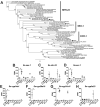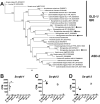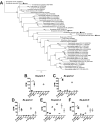Transcriptional profiles in Strongyloides stercoralis males reveal deviations from the Caenorhabditis sex determination model
- PMID: 33859232
- PMCID: PMC8050236
- DOI: 10.1038/s41598-021-87478-3
Transcriptional profiles in Strongyloides stercoralis males reveal deviations from the Caenorhabditis sex determination model
Abstract
The human and canine parasitic nematode Strongyloides stercoralis utilizes an XX/XO sex determination system, with parasitic females reproducing by mitotic parthenogenesis and free-living males and females reproducing sexually. However, the genes controlling S. stercoralis sex determination and male development are unknown. We observed precocious development of rhabditiform males in permissive hosts treated with corticosteroids, suggesting that steroid hormones can regulate male development. To examine differences in transcript abundance between free-living adult males and other developmental stages, we utilized RNA-Seq. We found two clusters of S. stercoralis-specific genes encoding predicted transmembrane proteins that are only expressed in free-living males. We additionally identified homologs of several genes important for sex determination in Caenorhabditis species, including mab-3, tra-1, fem-2, and sex-1, which may have similar functions. However, we identified three paralogs of gld-1; Ss-qki-1 transcripts were highly abundant in adult males, while Ss-qki-2 and Ss-qki-3 transcripts were highly abundant in adult females. We also identified paralogs of pumilio domain-containing proteins with sex-specific transcripts. Intriguingly, her-1 appears to have been lost in several parasite lineages, and we were unable to identify homologs of tra-2 outside of Caenorhabditis species. Together, our data suggest that different mechanisms control male development in S. stercoralis and Caenorhabditis species.
Conflict of interest statement
The authors declare no competing interests.
Figures





Similar articles
-
Comparative genomics of gene expression in the parasitic and free-living nematodes Strongyloides stercoralis and Caenorhabditis elegans.Genome Res. 2004 Feb;14(2):209-20. doi: 10.1101/gr.1524804. Genome Res. 2004. PMID: 14762059 Free PMC article.
-
Regulation of Life Cycle Checkpoints and Developmental Activation of Infective Larvae in Strongyloides stercoralis by Dafachronic Acid.PLoS Pathog. 2016 Jan 4;12(1):e1005358. doi: 10.1371/journal.ppat.1005358. eCollection 2016 Jan. PLoS Pathog. 2016. PMID: 26727267 Free PMC article.
-
RNAseq analysis of the parasitic nematode Strongyloides stercoralis reveals divergent regulation of canonical dauer pathways.PLoS Negl Trop Dis. 2012;6(10):e1854. doi: 10.1371/journal.pntd.0001854. Epub 2012 Oct 25. PLoS Negl Trop Dis. 2012. PMID: 23145190 Free PMC article.
-
The 'nuclear option' revisited: Confirmation of Ss-daf-12 function and therapeutic potential in Strongyloides stercoralis and other parasitic nematode infections.Mol Biochem Parasitol. 2022 Jul;250:111490. doi: 10.1016/j.molbiopara.2022.111490. Epub 2022 Jun 11. Mol Biochem Parasitol. 2022. PMID: 35697206 Review.
-
The ever-expanding neuropeptide gene families in the nematode Caenorhabditis elegans.Parasitology. 2005;131 Suppl:S109-27. doi: 10.1017/S0031182005009376. Parasitology. 2005. PMID: 16569285 Review.
Cited by
-
Carbon dioxide shapes parasite-host interactions in a human-infective nematode.Curr Biol. 2025 Jan 20;35(2):277-286.e6. doi: 10.1016/j.cub.2024.11.036. Epub 2024 Dec 23. Curr Biol. 2025. PMID: 39719698
-
Carbon dioxide shapes parasite-host interactions in a human-infective nematode.bioRxiv [Preprint]. 2024 Mar 31:2024.03.28.587273. doi: 10.1101/2024.03.28.587273. bioRxiv. 2024. Update in: Curr Biol. 2025 Jan 20;35(2):277-286.e6. doi: 10.1016/j.cub.2024.11.036. PMID: 38585813 Free PMC article. Updated. Preprint.
-
Identification of miRNAs of Strongyloides stercoralis L1 and iL3 larvae isolated from human stool.Sci Rep. 2022 Jun 15;12(1):9957. doi: 10.1038/s41598-022-14185-y. Sci Rep. 2022. PMID: 35705621 Free PMC article.
-
A standard workflow for community-driven manual curation of Strongyloides genome annotations.Philos Trans R Soc Lond B Biol Sci. 2024 Jan 15;379(1894):20220443. doi: 10.1098/rstb.2022.0443. Epub 2023 Nov 27. Philos Trans R Soc Lond B Biol Sci. 2024. PMID: 38008112 Free PMC article.
-
Fisher vs. the Worms: Extraordinary Sex Ratios in Nematodes and the Mechanisms that Produce Them.Cells. 2021 Jul 15;10(7):1793. doi: 10.3390/cells10071793. Cells. 2021. PMID: 34359962 Free PMC article. Review.
References
Publication types
MeSH terms
Substances
Grants and funding
LinkOut - more resources
Full Text Sources
Other Literature Sources
Research Materials
Miscellaneous

